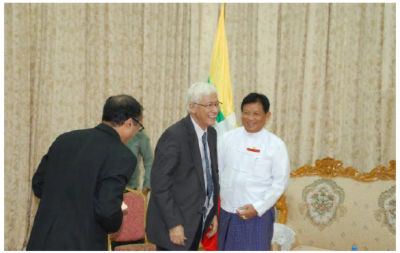| |
.. |
|
The Cambodian Election
by Damaso G. Magbual, Member, NAMFREL National
Council
Chairperson, Asian network for Free Elections (ANFREL)
|
|
from
NAMFREL Election Monitor Vol.3, No.3 |
|
|
 |
| Mr.
Magbual in Myanmar |
. |
... |
ANFREL deployed a team of
eight experts from six Asian countries headed by this
writer, to observe the Parliamentary Elections in Cambodia
on July 28, 2013. Our findings were presented to a group of
diplomats from the European Union (15 embassies represented)
in Bangkok, Thailand, hosted by the Swiss Embassy.
Among the most positive development was the significant
decrease in electoral violence compared to past elections.
Several interlocutors credited the active participation of
Cambodia’s youth for much of the more peaceful situation. As
one said, “Unlike their elders, they reject violence as a
means of resolving conflicts in the electoral process”. It
was estimated that the youth represented more than 35% of
the registered voters. |
|
Political Situation
There was a relatively widespread consensus that the country has
slid backwards democratically for the past ten years. It has come
under a unified control of the ruling party (CPP). Cambodia is now a
de facto one-party system that can be credited to the older
generation of party leaders having grown up with a Communist/Maoist
mindset. The party’s control over all branches of government and
democratic institutions has an obvious and undeniably harmful effect
on the country’s elections.
Among the most compromised institutions, the judicial system has
been almost completely undermined and exists primarily as a venue
where political connections or financial resources are the sole
determinants of the courts’ decisions. The courts have been used as
a weapon of repression against opposition party leaders, independent
voices in the media, amongst many others. Consequently, election
stakeholders have no confidence or expectation that the courts can
play their proper role in electoral dispute resolution.
The National Election Committee (NEC)
The NEC has long been a highly politicized body. It is far from
exhibiting the independence, impartiality and neutrality expected of
an election body. Recommendations by domestic as well as
international observers on the recruitment, selection and
appointment of NEC Commissioners after each electoral exercise
since1998 have been ignored by the legislature and calls for greater
autonomy and professionalism from the NEC have similarly fallen on
deaf ears.
Basic Issues Raised
Problems with the voters’ list were the most discussed, studied, and
criticized aspect of the NEC’s preparation. The inaccuracies of the
voters’ list created a number of harmful effects, namely, direct
disenfranchisement of voters who registered but their names were not
in the list; the opportunity for fraud given the incorrect and
duplicate names that were found in the list; serious harm on the
public’s confidence on the legitimacy of the election.
The NEC printed over 2.6 million or 27% excess ballots, a number far
exceeding accepted norms and standards in established democracies.
No actual justification was given except that the NEC “print ballots
in books of 50s and to provide adequate excess ballots to every
polling station”. Given that the NEC officials are not trusted and
the voters’ list have excess names, the high number of extra
ballots, contributed to an erosion of public trust in the election.
The NEC introduced a notorious invention called “Identification Card
for the Election” (ICE). ICEs were issued by the commune leaders to
voters with no identification cards to enable them to vote. The
issuance of so many ICE cards created a fear of significant fraud
since the commune leaders who issued them were mostly partisans of
the ruling party.
This election saw the issue of ethnic Vietnamese voters, citizens
and non-citizens, become a highly controversial topic. Accusations
ran rampant that on election day, groups of Vietnamese were bussed
in to vote for the ruling party.
Media
The media in Cambodia tilts heavily towards the ruling party. All
the television stations are government owned, the vast majority of
radio stations are government owned and the leading Khmer language
daily is owned by one sympathetic to the ruling party. A revealing
example of media bias was the coverage surrounding opposition leader
Sam Rainsy’s return to the country from exile. It was an event
wherein thousands of people took to the streets but there was no
coverage on TV or in the newspapers.
Most journalists work in an environment of explicit censorship. The
Ministry of Information’s regulations remain a constant threat of
being sued and tried in a biased court system.
Looking Ahead
Local analysts shared the opinion, before and after the election,
that change is forthcoming. The election results where the ruling
party lost 22 seats, reinforces the same message. There are a number
of social and economic factors that will hasten change. |
|
1. |
The growing inequality in the distribution of wealth has become
more pronounced under the ruling party. It is said that more than
half of the population live on less than two dollars a day. |
|
2. |
The increasing militancy of the youth as expressed in the last
election would be a wake-up call to the ruling party that their
clamour for change can no longer be ignored. |
|
3. |
The injustices perpetrated by the ruling elite and condoned by
the courts cannot last forever. The issue of land grabs is perhaps
the most glaring example though there are many others like the
adjudication and resolution of electoral disputes. |
|
4. |
The issue of ethnic Vietnamese (now Cambodian citizens) as well
as the Vietnamese migrant workers whom the Cambodians see as taking
away jobs and business opportunities from them, is a very sensitive
one that feeds on the emotions of the ethnic Khmers particularly
amongst the youth. The general public perceive the government as
tolerating their presence and even favouring them. |
|
|
|
| |
.
.
. |
|
| |
| |
|
|

